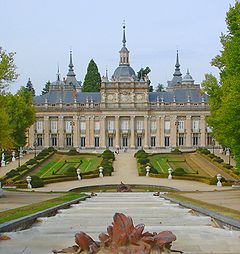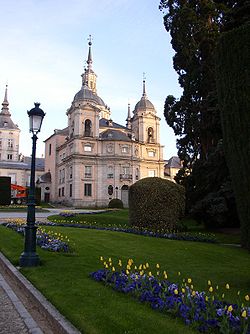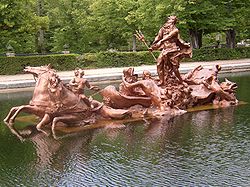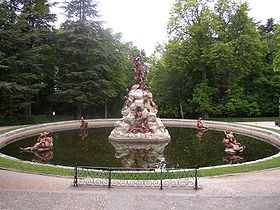
La Granja (palace)
Encyclopedia

San Ildefonso
San Ildefonso, or La Granja, or La Granja de San Ildefonso, is a town and municipality in the province of Segovia, Spain, situated some 54 km northwest of Madrid.-History:...
in the hills near Segovia
Segovia
Segovia is a city in Spain, the capital of Segovia Province in the autonomous community of Castile and León. It is situated north of Madrid, 30 minutes by high speed train. The municipality counts some 55,500 inhabitants.-Etymology:...
, 80 km north of Madrid
Madrid
Madrid is the capital and largest city of Spain. The population of the city is roughly 3.3 million and the entire population of the Madrid metropolitan area is calculated to be 6.271 million. It is the third largest city in the European Union, after London and Berlin, and its metropolitan...
, central Spain
Spain
Spain , officially the Kingdom of Spain languages]] under the European Charter for Regional or Minority Languages. In each of these, Spain's official name is as follows:;;;;;;), is a country and member state of the European Union located in southwestern Europe on the Iberian Peninsula...
, formerly the summer residence of the Kings of Spain since the reign of Philip V
Philip V of Spain
Philip V was King of Spain from 15 November 1700 to 15 January 1724, when he abdicated in favor of his son Louis, and from 6 September 1724, when he assumed the throne again upon his son's death, to his death.Before his reign, Philip occupied an exalted place in the royal family of France as a...
. The palace is in a restrained baroque
Baroque architecture
Baroque architecture is a term used to describe the building style of the Baroque era, begun in late sixteenth century Italy, that took the Roman vocabulary of Renaissance architecture and used it in a new rhetorical and theatrical fashion, often to express the triumph of the Catholic Church and...
style surrounded by extensive gardens in the French manner and sculptural fountains. It is now open to the public as a museum.
History
Due to their location on the forested northern slopes of the Sierra de GuadarramaSierra de Guadarrama
The Sierra de Guadarrama is a mountain range forming the main eastern section of the Sistema Central, the system of mountain ranges at the centre of the Iberian Peninsula. It is located between the Sierra de Gredos in the province of Ávila, and Sierra de Ayllón in the province of Guadalajara...
, these were favourite hunting grounds for many Castilian
Kingdom of Castile
Kingdom of Castile was one of the medieval kingdoms of the Iberian Peninsula. It emerged as a political autonomous entity in the 9th century. It was called County of Castile and was held in vassalage from the Kingdom of León. Its name comes from the host of castles constructed in the region...
kings. In the 15th century, Henry IV
Henry IV of Castile
Henry IV , King of the Crown of Castile, nicknamed the Impotent , was the last of the weak late medieval kings of Castile...
of Castile
Crown of Castile
The Crown of Castile was a medieval and modern state in the Iberian Peninsula that formed in 1230 as a result of the third and definitive union of the crowns and parliaments of the kingdoms of Castile and León upon the accession of the then King Ferdinand III of Castile to the vacant Leonese throne...
built the first hunting lodge on the site, along with a small shrine dedicated to San Ildefonso (Saint Ildefonsus
Ildephonsus of Toledo
Saint Ildefonsus or Ildephonsus was the metropolitan bishop of Toledo from 657 until his death. He was a Visigoth and his Gothic name was Hildefuns, which evolved into the Castilian name Alfonso. Ildefonsus, however, is known as San Ildefonso in Castilian and there are several places named after him...
), which gave this place its first name.
Isabella I of Castile
Isabella I of Castile
Isabella I was Queen of Castile and León. She and her husband Ferdinand II of Aragon brought stability to both kingdoms that became the basis for the unification of Spain. Later the two laid the foundations for the political unification of Spain under their grandson, Charles V, Holy Roman Emperor...
granted both buildings to the monks of the Parral
Santa Maria del Parral
Santa Maria del Parral is a convent of the Hieronymites just outside the walls of Segovia, Spain, founded by King Henry IV of Castile in 1454. Despite a generally irreligious life, Henry was finally buried in the sister-house of Santa María de Guadalupe...
monastery in Segovia, who built a granja (farm) and an almshouse alongside.

Philip V of Spain
Philip V was King of Spain from 15 November 1700 to 15 January 1724, when he abdicated in favor of his son Louis, and from 6 September 1724, when he assumed the throne again upon his son's death, to his death.Before his reign, Philip occupied an exalted place in the royal family of France as a...
, after his summer palace nearby at Valsaín burned to a shell. Beginning in 1721, Philip began building a new palace and gardens modelled on Versailles
Palace of Versailles
The Palace of Versailles , or simply Versailles, is a royal château in Versailles in the Île-de-France region of France. In French it is the Château de Versailles....
, built by his grandfather, Louis XIV of France
Louis XIV of France
Louis XIV , known as Louis the Great or the Sun King , was a Bourbon monarch who ruled as King of France and Navarre. His reign, from 1643 to his death in 1715, began at the age of four and lasted seventy-two years, three months, and eighteen days...
. Like Versailles it embraced a cour d'honneur
Cour d'Honneur
Cour d'Honneur is the architectural term for defining a three-sided courtyard, created when the main central block, or corps de logis, is flanked by symmetrical advancing secondary wings, containing minor rooms...
on the approaching side, and formal gardens, with a main axis centered on the palace, that were surrounded by woodland in which further hidden garden features were disposed. Like Versailles, La Granja began as a retreat from the court but became a center of royal government.
For the architect, Philip began with an unpretentious project by the Spanish architect Teodoro Ardemans
Teodoro Ardemans
Teodoro de Ardemans was a Spanish architect and painter.He was a disciple of the painter Claudio Coello, although he mainly practiced architecture; the municipality of Toledo named him master of the Cathedral of Toledo. In 1702, King Philip V of Spain named him to succeed José del Olmo as the...
, incorporating a chapel centered on one facade, which was enlarged in a second phase, ca 1728-34 under Andrea Procaccini
Andrea Procaccini
Andrea Procaccini was an Italian painter of the Baroque period, active in Rome as well as in Spain.Born in Rome, he trained in the studio of Carlo Maratta. He painted the prophet Daniel for a series of twelve prophets made for San Giovanni Laterano. He assisted in the establishment of the papal...
and Sempronio Subisati, who provided the courtyards in the flanks, then given its definitive character by Filippo Juvarra
Filippo Juvarra
Filippo Juvarra was an Italian architect and stage set designer.-Biography:Filippo Juvarra was an Italian Baroque architect working in the early part of the eighteenth century. He was born in Messina, Sicily, to a family of goldsmiths and engravers...
, who was brought from Turin, based on recommendations in the circle of Philip's second queen, Elizabeth Farnese of Parma, and his assistant, Giovanni Battista Sacchetti.
When the King decided to abdicate in 1724, his intention was to retire to La Granja. Unfortunately Philip's heir, King Louis I
Louis of Spain
Louis I was reigned as King of Spain from 15 January 1724 until his death in August the same year...
, died that same year, and Philip had to return to the throne. Consequently, a place designed for leisure and quiet retreat thus became an important meeting place for the King, his ministers and the court. The town of San Ildefonso expanded to provide housing and services to the courtiers who wanted a place near the king's favourite residence. Military barracks, a collegiate church (1721–1724, built to designs of Teodoro Ardemans, and dedicated to the Holy Trinity, 22 December 1723), and even a royal glass factory (1728) were built to provide for the palace. The glass factory, which had some initial successes from 1720 at Nuevo Baztan
Nuevo Baztán
Nuevo Baztán is a municipality southeast of Madrid, near Alcalá de Henares, Spain. It consists of a small historic centre and modern housing estates. The historic centre was designed as an industrial and housing complex laid out on a grid plan...
in the province of Madrid, was moved under the direction of its Catalan foreman, Ventura Sit, to San Ildefonso, where supplies of timber were plentiful, and a royal patron was near. The best glass of Venetian type produced in the works dates from the last quarter of the 18th century. As La Granja de San Ildefonso, the glassworks continue today as a subsidiary of Saint Gobain.
The church was selected as his burial site by Philip, marking a break with his Habsburg predecessors. The frescoes by Giambattista Tiepolo, completed by Francisco Bayeu, were badly damaged in a fire of 1918.
Philip's successor Ferdinand VI
Ferdinand VI of Spain
Ferdinand VI , called the Learnt, was King of Spain from 9 July 1746 until his death. He was the fourth son of the previous monarch Philip V and his first wife Maria Luisa of Savoy...
bequeathed the royal site of San Ildefonso, with all it contained, to his father's second wife, Isabel Farnese. At her death in 1766 it reverted to the Crown in the person of Charles III
Charles III of Spain
Charles III was the King of Spain and the Spanish Indies from 1759 to 1788. He was the eldest son of Philip V of Spain and his second wife, the Princess Elisabeth Farnese...
.
For the next two hundred years, La Granja was the court's main summer palace, and many royal weddings and burials, state treaties and political events took place within its walls.
Currently this royal site forms part of Spain's Patrimonio Nacional
Patrimonio Nacional
The Consejo de Administración del Patrimonio Nacional is a Spanish state agency, under the jurisdiction of the Minister of the Presidency by delegation of the Prime Minister of Spain, that administers the sites owned by the Spanish...
, which holds, and maintains many of the Crown's lands and palaces.


Flemish
Flemish can refer to anything related to Flanders, and may refer directly to the following articles:*Flemish, an informal, though linguistically incorrect, name of any kind of the Dutch language as spoken in Belgium....
tapestries
Tapestry
Tapestry is a form of textile art, traditionally woven on a vertical loom, however it can also be woven on a floor loom as well. It is composed of two sets of interlaced threads, those running parallel to the length and those parallel to the width ; the warp threads are set up under tension on a...
.
The gardens
Extending over 1500 acres (6.1 km²), the gardens around the palace are one of the best examples of 18th-century European garden design. The French designer from the official French royal offices of Robert de CotteRobert de Cotte
Robert de Cotte was a French architect-administrator, under whose design control of the royal buildings of France from 1699, the earliest notes presaging the Rococo style were introduced. First a pupil of Jules Hardouin-Mansart, he later became his brother-in-law and his collaborator...
, René Carlier, used the natural slope from the mountains to the palace grounds both as an aid for visual perspective and as a source for sufficient head to make water shoot out of the twenty-six sculptural fountains that decorate the park. Of the elaborate "Baths of Diana", focus of several garden axes, the chronically depressed Philip remarked, "It has cost me three millions and amused me three minutes."
Sculptors arrived from Paris to execute designs on the site; they included René Frémin (1672–1744, at La Granja until 1738), to whom the execution of many vases and sculptures was attributed in 18th-century inventories, Jean Thierry, and others who are little more than names in archival references.
All of the fountains represent themes from classical mythology
Mythology
The term mythology can refer either to the study of myths, or to a body or collection of myths. As examples, comparative mythology is the study of connections between myths from different cultures, whereas Greek mythology is the body of myths from ancient Greece...
, including Greek
Greek mythology
Greek mythology is the body of myths and legends belonging to the ancient Greeks, concerning their gods and heroes, the nature of the world, and the origins and significance of their own cult and ritual practices. They were a part of religion in ancient Greece...
deities, allegories
Allegory
Allegory is a demonstrative form of representation explaining meaning other than the words that are spoken. Allegory communicates its message by means of symbolic figures, actions or symbolic representation...
and scenes from myth
Mythology
The term mythology can refer either to the study of myths, or to a body or collection of myths. As examples, comparative mythology is the study of connections between myths from different cultures, whereas Greek mythology is the body of myths from ancient Greece...
s. They are cast in lead
Lead
Lead is a main-group element in the carbon group with the symbol Pb and atomic number 82. Lead is a soft, malleable poor metal. It is also counted as one of the heavy metals. Metallic lead has a bluish-white color after being freshly cut, but it soon tarnishes to a dull grayish color when exposed...
to prevent corrosion
Corrosion
Corrosion is the disintegration of an engineered material into its constituent atoms due to chemical reactions with its surroundings. In the most common use of the word, this means electrochemical oxidation of metals in reaction with an oxidant such as oxygen...
, and painted over to simulate bronze
Bronze
Bronze is a metal alloy consisting primarily of copper, usually with tin as the main additive. It is hard and brittle, and it was particularly significant in antiquity, so much so that the Bronze Age was named after the metal...
, a nobler material, or lacquered over white oxydised lead to imitate marble. A group of richly sculptural vases have been attributed to designs by the "dazzling maverick" Gilles-Marie Oppenord, which were probably forwarded through the offices of Robert de Cotte
Robert de Cotte
Robert de Cotte was a French architect-administrator, under whose design control of the royal buildings of France from 1699, the earliest notes presaging the Rococo style were introduced. First a pupil of Jules Hardouin-Mansart, he later became his brother-in-law and his collaborator...
, overseeing French royal building projects as intendant des Bâtiments du Roi
Bâtiments du Roi
The Bâtiments du Roi was a division of Department of the household of the Kings of France in France under the Ancien Régime. It was responsible for building works at the King's residences in and around Paris.-History:...
. Bruno Pons noted in the sculptural vases "an almost excessively brilliant style, quite distinct from French royal taste and showing an undeniably superior understanding of ornament
Ornament (architecture)
In architecture and decorative art, ornament is a decoration used to embellish parts of a building or object. Large figurative elements such as monumental sculpture and their equivalents in decorative art are excluded from the term; most ornament does not include human figures, and if present they...
".
The original waterworks and piping are still functional. They rely purely on gravity to project water up to the forty-meter height of the fountain jet of Perseus and Andromeda. An artificial lake, El Mar, "the Sea", lies secluded at the highest point of the park, and provides a reservoir and water pressure for the whole system.
Today, only a few fountains are active each day. Twice a year, on the feast days of San Fernando (Saint Ferdinand) and San Luis (Saint Louis
Louis IX of France
Louis IX , commonly Saint Louis, was King of France from 1226 until his death. He was also styled Louis II, Count of Artois from 1226 to 1237. Born at Poissy, near Paris, he was an eighth-generation descendant of Hugh Capet, and thus a member of the House of Capet, and the son of Louis VIII and...
), all twenty-six fountains are set to play, providing a memorable show.

